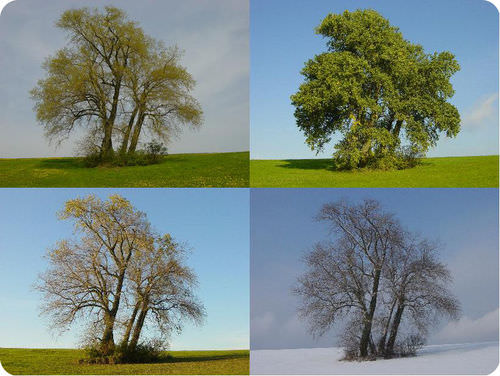9.16 休假时间
章节大纲
-
Could life exist without the leaf?
::没有叶子,生命会存在吗?A leaf looks so simple. But it is actually a very complex structure. And it may be one of the most important organs in all kingdoms. Life as we know it could not exist without leaves. Why? One word: .
::叶子看起来如此简单。 但实际上它是一个非常复杂的结构。 它可能是所有王国中最重要的器官之一。 我们知道生命不可能没有叶子存在。为什么?一个词:Leaves
::休假请请假Plants have specialized organs that help them survive and reproduce in a great diversity of habitats . Major organs of most plants include , , and leaves. Leaves are the keys not only to plant life but to all life. The primary role of leaves is to collect sunlight and make food by photosynthesis . Despite the fundamental importance of the work they do, there is great diversity in the leaves of plants. However, given the diversity of habitats in which plants live, it’s not surprising that there is no single best way to collect solar energy for photosynthesis.
::植物拥有有助于它们生存和繁殖在多种生境中的专门器官。大多数植物的主要器官包括,和叶子。叶子不仅是植物生命的钥匙,也是所有生命的钥匙。叶子的主要作用是收集阳光和通过光合作用做食物。 尽管它们的工作具有根本重要性,但植物叶上存在巨大的多样性。 然而,鉴于植物所居住的生境的多样性,没有一种最佳方法收集太阳能作为光合作用。Leaf Variation
::叶叶变换Leaves may vary in size, shape, and their arrangement on stems. Nonflowering have three basic types of leaves: microphylls (“tiny leaves”), fronds , and needles . Figure describes each type.
::叶子的大小、形状和花茎安排可能不同。 非开花叶有三种基本叶子类型:微粒(“小叶子 ”) 、 羽毛和针头。 图说明了每种类型。Leaf variation in nonflowering plants reflects their evolutionary origins. Can you explain how?
::非开花植物叶叶的变异反映了其进化起源。 你能解释一下吗?Flowering vascular plants also have diverse leaves. However, the leaves of all flowering plants have two basic parts in common: the blade and petiole . The blade of the leaf is the relatively wide, flat part of the leaf that gathers sunlight and undergoes photosynthesis. The petiole is the part that attaches the leaf to a stem of the plant. This occurs at a node.
::然而,所有开花植物的叶子都有两个共同的基本部分:刀片和小叶类。叶片是相对宽的、平的叶片,收集阳光并进行光合作用。小叶片是叶子与植物根部相连的部分。这发生在节点上。Flowering plant leaves vary in how the leaves are arranged on the stem and how the blade is divided. This is illustrated in Figure . Generally, the form and arrangement of leaves maximizes light exposure while conserving , reducing wind resistance, or benefiting the plant in some other way in its particular habitat.
::花叶在树干上的叶子排列方式和刀片的划分方式各有不同。图1说明了这一点。一般而言,叶子的形式和安排在保存、减少风阻力或以某种其他方式使植物在特定生境上受益的同时,最大限度地增加了光暴露。-
Leaves arranged in whorls encircle upright stems at intervals. They collect sunlight from all directions.
::叶子排列在螺旋圈的右上方 每隔一段时间会从各个方向收集阳光 -
Leaves arranged in basal rosettes take advantage of warm temperatures near the ground.
::利用靠近地面的温暖温度,在巴萨尔玫瑰花中安排的叶子。 -
Leaves arranged in alternate or opposing pairs collect light from above. They are typically found on plants with a single, upright stem.
::替代或对立两对安排的叶子从上面收集光线,通常在单干线直立的植物上找到。 -
The blades of simple leaves are not divided. This provides the maximum surface area for collecting sunlight.
::简单叶片的叶片不分割,这为收集阳光提供了最大的表面面积。 -
The blades of compound leaves are divided into many smaller leaflets. This reduces wind resistance and water loss.
::复合叶片分为许多较小的传单,减少风阻力和水流失。
Leaf variation in flowering plants may include variations in the arrangement of leaves and the divisions of the blade.
::开花植物叶叶的变异可能包括叶子安排和叶片分割的变异。Seasonal Changes in Leaves
::休假时间的季节性变化Even if you don’t live in a place where leaves turn color in the fall, no doubt you’ve seen photos of their “fall colors” (see Figure ). The leaves of many plants turn from green to other, glorious colors during autumn each year. The change is triggered by shorter days and cooler temperatures. Leaves respond to these environmental stimuli by producing less chlorophyll . This allows other leaf pigments—such as oranges and yellows—to be seen.
::即使你不住在一个叶子在秋天变色的地方,你无疑也见过过这些植物的“落叶颜色”照片(见图 ) 。 每年秋天,许多植物的叶子会从绿色转向其他光荣的颜色。 变化是由较短的天数和更冷的温度引发的。 叶子通过少生产叶绿素来应对这些环境刺激。 这让其他叶色(如橙色和黄色)被看到。A deciduous tree goes through dramatic seasonal changes each year. Can you identify the seasons in the photo?
::每年一棵枯萎的树都会经历巨大的季节性变化。 你能辨别照片中的季节吗 ?After leaves turn color in the fall, they may all fall off the plant for the winter. Plants that shed their leaves seasonally each year are called deciduous plants. Shedding leaves is a strategy for reducing water loss during seasons of extreme dryness. On the downside, the plant must grow new leaves in the spring, and that takes a lot of energy and matter. Some plants may “bank” energy over the winter by storing food. That way, they are ready to grow new leaves as soon as spring arrives.
::秋天叶变色后,它们都可能会在冬季从植物中掉下来。每年季节性地脱叶的植物被称为低潮植物。 脱叶叶是减少极端干燥季节缺水的战略。 在下游,植物必须在春季种植新的叶子,这需要大量能量和物质。 有些植物可能通过储存食物在冬季“储存”能源。 这样,它们就准备在春天一到来时就种植新的叶子。Evergreen plants have a different strategy for adapting to seasonal dryness. They don’t waste energy and matter growing new leaves each year. Instead, they keep their leaves and stay green year-round. However, to reduce water loss, they have needle-like leaves with very thick cuticle . On the downside, needle-like leaves reduce the surface area for collecting sunlight. This is one reason that needles may be especially rich in chlorophyll, as you can see from the dark green pine needles in Figure . This is also an important adaptation for low levels of sunlight, allowing evergreens to live far from the equator.
::长青植物有不同的适应季节性干燥的战略。 它们不会浪费能源和物质每年种植新叶子。 相反,它们保留叶子并保持全年绿化。 但是,为了减少水流失,它们有针状的叶子,有厚厚的切片。 在下边,针状的叶子减少了收集阳光的表面积。 这是针头可能特别丰富的叶绿素的原因之一,您可以从图中的暗绿松针中看到这一点。 这也是对低阳光水平的重要适应,让常青能远离赤道。Compare the color of the evergreen needles and the deciduous leaf. Why is the darker color of the needles adaptive?
::比较长青针和淡薄叶的颜色。 为什么针的更暗颜色能适应?Summary
::摘要-
The primary function of leaves is to collect sunlight and make food by photosynthesis.
::叶子的主要功能是收集阳光,用光合作用做食物。 -
In a deciduous plant, leaves seasonally turn color and fall off the plant. They are replaced with new leaves later in the year.
::在一个衰落的植物中,叶子会季节性地变色,并会从植物中掉下来,年末用新的叶子取代。 -
An evergreen plant keeps its green leaves year-round. It may have needle-like leaves to reduce water loss.
::绿色植物全年保持绿叶,可能有针状叶来减少缺水。
Review
::回顾-
Name the two main parts of an angiosperm leaf. What is the function of each part?
::命名血管膜叶的两个主要部分。 每个部分的功能是什么 ? -
Identify strategies used by deciduous and evergreen plants to adapt to seasonal dryness.
::确定低效和常青植物为适应季节性干燥而采用的战略。 -
Relate leaf variation to environmental variation.
::将叶叶变化与环境变化相对应。
-
Leaves arranged in whorls encircle upright stems at intervals. They collect sunlight from all directions.




